|

 Up
Up 
 The
Prize
The
Prize
Patrol 
(You are here.)



  Need
to Need
to
find your
bearings?
Try
these
navigation aids:
If
this is your first
visit, please stop by:
Something
to share?
Please:



|
|
 n
1906, the anti-Wright skeptics in the European aviation community had
converted the press. European newspapers, especially in France, were
openly derisive, calling them bluffeurs (bluffers). The Paris
edition of the New York Herald summed up Europe's opinion of the
Wright brothers in an editorial on February 10, 1906: "The Wright
have flown or they have not flown. They possess a machine or they do not
possess one. They are in fact either fliers or liars. It is difficult to
fly. It's easy to say, 'We have flown.'" n
1906, the anti-Wright skeptics in the European aviation community had
converted the press. European newspapers, especially in France, were
openly derisive, calling them bluffeurs (bluffers). The Paris
edition of the New York Herald summed up Europe's opinion of the
Wright brothers in an editorial on February 10, 1906: "The Wright
have flown or they have not flown. They possess a machine or they do not
possess one. They are in fact either fliers or liars. It is difficult to
fly. It's easy to say, 'We have flown.'"
And the French had some reason to be cocky. The French aeronautical
revival, inspired by Octave Chanute's address to the Aero-Club de France
in early 1903, was beginning to bear fruit. At the urging of
Ernest
Archdeacon and
Ferdinand Ferber, French aviators had experimented with
gliders derived from Wright designs. Their success was limited — none of
them repeated the careful research in lift and drag that had enabled the
Wrights to build their record-breaking 1902 glider. More importantly, they
misunderstood the function and necessity of the Wright's control system
and discarded it. Instead, the French endeavored to build an inherently
stable flying machine that would need little control input, and they were
satisfied with their own results.
When he first heard of the Wrights' experiments, Ferber had been
building gliders since 1899 without much success. In June 1902, he
built a crude copy of the Wright's 1901 glider as described to him
by
Octave Chanute and flew it. Encouraged by its performance, he
built a slightly larger version, mounted a 6 hp engine and two
coaxial propellers and tried unsuccessfully to fly the aircraft in
December 1902 while suspended from a crane. The dogged Ferber went
back to unpowered gliders and in 1904 built an aircraft with
Wright-type biplane wings with an elevator in front and a horizontal
stabilizer in back. This would become a standard European design.
In 1904, Ernest Archdeacon contracted the military balloon
factory at Meudon to build his own copy of the 1902 Wright glider –
by this time, the design had come to be known as an aeroplane de type Wright.
He also recruited a young
architectural student,
Gabriel Voison,
to serve as pilot. Ferber, who at this time had more gliding
experience than any other living European, also assisted. After testing
the glider for several weeks, Voison was making flights up to 65 feet in length,
and Archdeacon gleefully announced to the Aero-Club de France that Voison
had mastered skill of piloting an aircraft. It mattered little that the
Wrights had made flights almost ten times as long in their 1902 glider.
Archdeacon was confident that the French could now design a glider that
would "do as well as the Wright brothers."
To spur the progress of aviation in Europe – especially France –
well-heeled enthusiasts offered rich prizes. Archdeacon himself put up the
Coupe d'Aviation Ernest Archdeacon, a silver trophy that would go
to the first person to fly a powered airplane 25 meters (80 feet). The
Aero-Club de France offered a prize of 1500 francs to the first person to
fly 100 meters, or 330 feet. And Archdeacon collaborated with Henri
Deutsch de la Meurthe to establish the Grand Prix d'Aviation, a
prize of 50,000 francs to the first person to fly a kilometer in a circular
course.
Europe got to work. In 1905, Voison collaborated with both Archdeacon and Louis Bleriot
– a manufacturer of
automotive components – building and flying gliders with "cellular" wings
and box-kite tails, similar to kites tested a decade earlier by
Lawrence Hargrave. These too would become standard elements of
European aircraft design. Samuel F.
Cody, an American cowboy is Great Britain, flew a kite-glider with
ailerons. Rumanian
Trajan Vuia made a series of short hops in a monoplane powered by a
carbonic acid gas motor. In Denmark, J. C. R. Ellehammer made a 42-meter
circular flight in an odd biplane while tethered to a post. Leon
Levavasseur perfected two light airplane engines of 24 and 50 horsepower
he named "Antoinette" motors after the daughter of his partner,
Jules Gastambide. These engines
would become the mainstay of European aviation during its earliest years.
But the aviator that captured Europe's attention was
Alberto
Santos-Dumont, a Brazilian-born immigrant to France and the son of a
wealthy coffee-plantation owner. Santos was a talented engineer who began
racing motorized tricycles, then turned to lighter-than-air flight. He
puttered about in odd-shaped dirigibles of his own design over the
rooftops of Paris at the turn of the twentieth century, often crashing
slowly and safely into trees and chimneys. In 1904, he visited the St.
Louis Exposition in the United States, where he saw demonstrations of
Octave Chanute's gliders and heard about the work of the Wright brothers.
Inspired, he turned his talents to powered aircraft.
In July of 1906, Santos-Dumont suspended an odd-looking airplane beneath his
dirigible Airship No. 14 for flight testing. Called the 14-bis ("14
encore"), this aircraft was a de type Wright, but the wings
met at a sharp upwards angle or "dihedral" to give it stability. At
the front was a pivoting box-kite assembly that acted as both an elevator
and a rudder. A 24-horsepower Antoinette engine turned a single propeller
that stuck out from behind. The pilot stood upright in a wicker basket,
much like a balloon pilot.
On September 13, 1906, Santos coaxed his ungainly aircraft off the
ground for a brief hop of 7 meters (23 feet) and made a hard landing.
After making repairs and refitting the craft with a 50-horsepower
Antoinette, Santos tried again. On October 23, he flew the 14-bis 60
meters (198 feet), winning the Archdeacon prize. He modified the craft
once again, adding ailerons and eliminating the rudder function of the
front control surfaces. On November 12, he flew 220 meters (726 feet),
capturing the 1500 franc prize from the Aero-Club for the first 100-meter
flight. It hardly mattered that the craft cumbersome and uncontrollable,
or that Santos abandoned the design a few months later, never to use it
again. He had flown – in public – and the French were beside
themselves with aeronautical optimism and national pride.
|
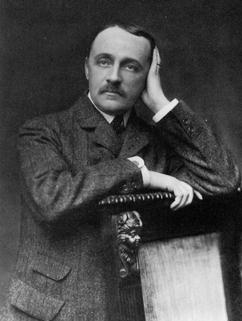
Ernest Archdeacon was a wealthy lawyer and
balloonist.
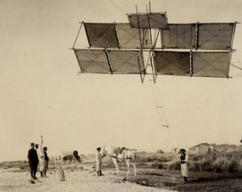
Ferber's 1902 interpretation of the 1901 Wright Glider was crude, but he did
repeat one of their essential experiments -- he flew it as a kite to get
some idea of the lift it would produce.
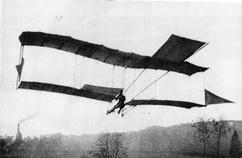
In 1904, Ferber designed and flew a glider with an elevator in front
and a fixed horizontal stabilizer in back. The two triangular
surfaces at the wingtips are movable rudders.
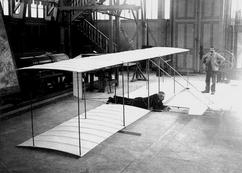
Archdeacon lying down in his 1904 interpretation of the 1902 Wright Glider,
soon to be piloted by Gabriel Voison (standing). Note that there seems to be
no method of warping the wings or turning the rudder.
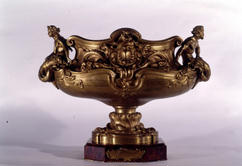
The Coupe d'Aviation Ernest Archdeacon.
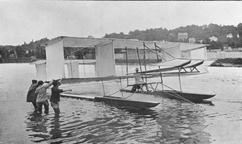
The 1905 Voison-Archdeacon glider of was
mounted on pontoons and launched by towing it behind a motorboat. It made
a short, uncontrolled flight on 8 June 1905. Louis Bleriot shot film
footage of this flight attempt which still exists today.
See it here.
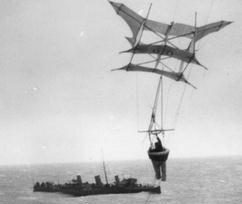
Samuel Cody had developed man-lifting kites for the British military
to use as aerial observation posts. These kites could reach
altitudes of 2000 feet (610 meters).
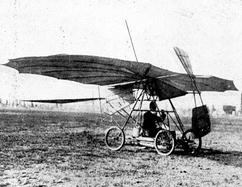
On 18 March 1906, Trajan Vuia made a short
hop-flight of about 40 feet (12 meters) before his engine quit.
While not successful, the tractor configuration (propeller first)
design foreshadowed things to come.
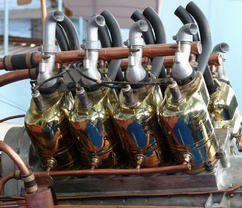
Levavasseur's "Antojnette" engine – he patented the "V-8" configuration.
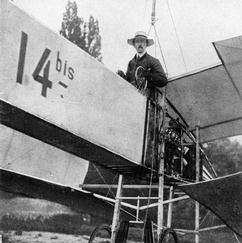
Alberto Santos-Dumont in the cockpit of the 14-bis.
|
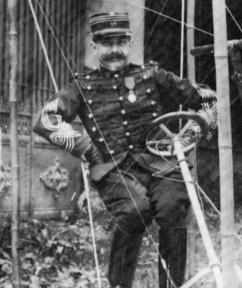
Ferdinand Ferber in his "Chariot Automobile" designed
to test propeller thrust. Ferber was a captain in an artillery battery in
the French Army.

Ferber flying his copy of the 1901 Wright glider.
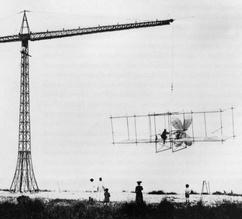
In December of 1902, Ferber attempted to fly a motorized copy of the
Wright's 1901 glider in
circles while attached to a rotating crane. The results were
entertaining, but unsuccessful.
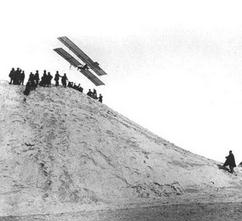
Voison flying Archdeacon's glider at Berck Beach, Pas-de-Calais,
France, on 3 April, 1904.
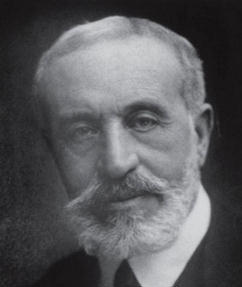
Henri Deutsch de la Meurthe
was a philanthropist and supporter of early aviation. He had made his
fortune in petroleum and was known as the "Oil King of Europe."
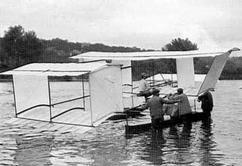
In the summer of 1905, Voison and Bleriot formed the first airplane
manufacturing company and built this glider along the lines of the
Voison-Archdeacon glider. A launch attempt on 18 July 1905 ended in
disaster with Voison almost drowning.
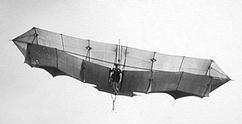
The 1905 Cody glider was launched and flown as a kite to reach altitude,
then the lines were dropped and it glided to the ground.
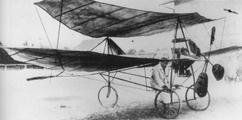
In August and September of 1906 Jacob Ellehammer made
several tethered hop-flights in this "semi-biplane.". Like Vuia's
airplane, it too had a tractor configuration.
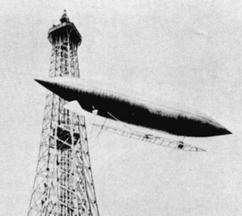
Santos Dumont in his No.
6 dirigible rounds the
Eiffel Tower on his way to winning the Deutsch Prize in 1901.
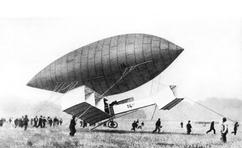
Santos-Dumont flew his 14-bis suspended from
a dirigible in August 1906.
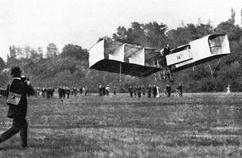
The prize-winning flight of the 14-bis on
October 23, 1906.
|